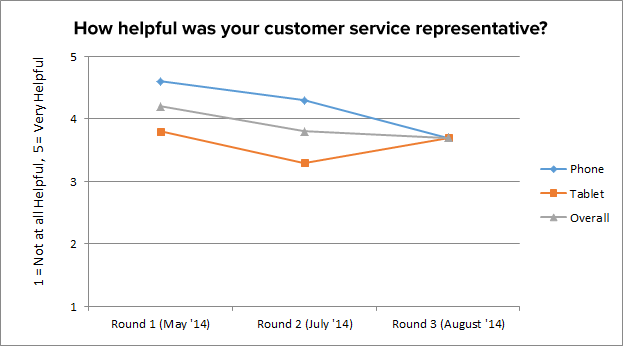
The meeting every executive should demand: the CX council

Creating a seamless customer experience is hard—especially at large organizations.
Even if you know there’s a problem that needs to be addressed, it’s difficult to make significant change. There’s more bureaucracy, more processes in place, and more people that need to be in the loop.
And it can be a challenge to get a handle on everything that CX encompasses: every piece of messaging that your customers and prospects interact with, at every touchpoint, on every channel.
How do you execute all of those interactions with the same tone, brand voice, and consistent quality, so that the customer journey feels like one cohesive experience?
Set up a customer experience council
We’ve seen some companies really run with the idea of collaboration, and how important it is for creating great experiences for their customers. You might consider bringing like minds together once a month (or quarter) for a dedicated conversation.
The best approach is to identify the 1-2 biggest areas of improvement for your customer experience that are related to your strategic business goals. And then, as a committee, prioritize how you’re going to approach improving those areas (and how they’re going to impact the bottom line).

For example, let’s say an e-commerce company called AcmeShop realizes that a large percentage of their customers are having a poor experience with customer support when they try to resolve an issue or get an answer to their question—and that it’s correlated with a drop-off in return purchases. In this case, the CX council decides to focus on improving customer satisfaction.
Invite respected representatives from each department
The activities of almost every department have an influence on the customer experience. And the transition between them should be seamless. That’s why it’s important to invite respected and talented members of every department.
It takes everyone’s buy-in to make visible change, so ask each department to send at least one representative. Even if it’s not the department leader, it should be someone who’s well-respected, enthusiastic, and who will bring some good ideas and lively debate to the table.
Keep in mind: The representatives from each department need to understand the value in improving the customer experience, because if they’re not bought in, then it will be almost impossible to make any progress.
And you should also open these meetings up to relevant guest attendees. If a new initiative is being launched that will have a big impact on the customer, it would benefit the CX Council to hear more about it. Invite the project owner to come in and talk about their initiative, and help everyone understand what it is and the implications it will have for the customer experience.
Define how you will measure success
It’s important that you define two metrics. First, define a metric that you can use to measure the entire customer experience as a whole.
In most cases, a good metric to use is your Net Promoter Score (NPS), which is a numerical scale that measures how likely your customers are to recommend your business to a friend or colleague (but depending on your business model, retention rate is also an accurate metric for measuring the customer experience).

Source: Medallia
Second, you need to define a metric that each department can use to measure success.
If AcmeShop is trying to improve their customer support experience, for example, what will each department involved measure themselves against to determine whether or not they’re making progress toward the overall CX metric you defined above?
Map out the customer journey
Before you can craft a seamless customer experience, you need to establish a baseline. And you can do that by mapping your current customer journey, which will help you figure out what it’s like for customers to interact with your brand over time and across different channels.
Example of a customer journey map
Customer journey mapping is an exercise that documents all of your client-facing interactions from start to finish—from the point when they first start doing research, all the way through making a purchase and becoming an advocate for your brand.
Which pain points affect all or most of your customers? Which critical interactions need to be improved? Are there any quick wins you can achieve by making small tweaks? What improvements will require a longer-term investment, but are still important? This exercise will help you identify your biggest issues so you can prioritize your CX efforts effectively.
Benchmark CX to track progress over time
Benchmarking is the process of measuring an initiative’s progress over time. A lot of companies like to run benchmarking studies because they show actual data as it changes over months and years.

Example of a benchmarking chart Benchmarking also has a few more benefits:
- First, it adds a quantitative dimension to the qualitative research you just did with your customer journey map, which can drive home your findings and add weight to your recommendations.
- Second, tracking your progress over time can show you whether the changes you implement are improving things or making them worse.
- Finally, the ongoing feedback you get with benchmarking will give you the direction you need to create a world-class customer experience.
And when everyone involved in your project sees the qualitative and quantitative results over time, it’s hard not to get excited about the progress you’re making.
Experiment to find what works for you
Once you’ve prioritized which parts of the customer experience to improve, the next step is to start experimenting. There’s no “magic bullet” for improving your customer experience. What works for your company will depend on your customers, your product, your industry, and your business model.
Based on your customer data and journey map, make educated guesses about which projects will move the needle on your key metrics, and run experiments to discover what works and what doesn’t for your specific situation.
The final word
Wherever, whenever, and however customers interact with your brand, they expect a seamless experience that has the same look and feel, level of service, and brand consistency. Every interaction either adds to or subtracts from their relationship with your company.
Great customer experiences don’t just happen. Organizations at the cutting edge of CX invest time and resources into weaving the entire customer journey into a cohesive experience their customer’s love.
And if you want to learn how to test and improve your CX, check out our free eBook, Measuring and Evaluating Your Omnichannel Customer Experience.






